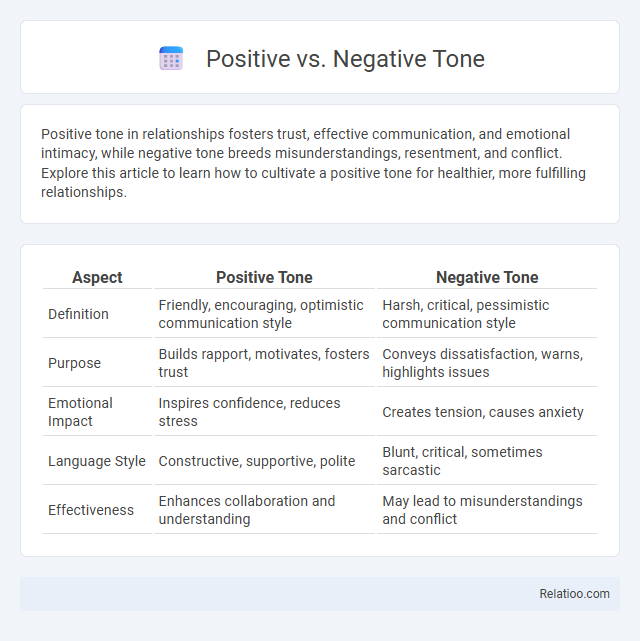Positive tone in relationships fosters trust, effective communication, and emotional intimacy, while negative tone breeds misunderstandings, resentment, and conflict. Explore this article to learn how to cultivate a positive tone for healthier, more fulfilling relationships.
Table of Comparison
| Aspect | Positive Tone | Negative Tone |
|---|---|---|
| Definition | Friendly, encouraging, optimistic communication style | Harsh, critical, pessimistic communication style |
| Purpose | Builds rapport, motivates, fosters trust | Conveys dissatisfaction, warns, highlights issues |
| Emotional Impact | Inspires confidence, reduces stress | Creates tension, causes anxiety |
| Language Style | Constructive, supportive, polite | Blunt, critical, sometimes sarcastic |
| Effectiveness | Enhances collaboration and understanding | May lead to misunderstandings and conflict |
Understanding Tone: Positive vs Negative
Understanding tone involves recognizing the emotional quality conveyed in communication, where positive tone reflects encouragement, optimism, and friendliness, while negative tone expresses criticism, pessimism, or hostility. Your ability to differentiate between positive and negative tone helps in interpreting messages accurately and responding appropriately in conversations or written content. Mastering the nuances of tone enhances effective communication, fostering better relationships and clearer understanding.
Defining Positive Tone in Communication
Positive tone in communication conveys warmth, enthusiasm, and respect, fostering trust and collaboration between parties. It employs affirming language, constructive feedback, and an encouraging attitude, which enhances message clarity and receiver engagement. This tone contrasts with negative tone, which may include criticism or hostility, potentially causing misunderstandings and conflict.
Characteristics of Negative Tone
Negative tone often features harsh, critical, or pessimistic language that can evoke feelings of discomfort or defensiveness in the reader. It is characterized by expressions of dissatisfaction, judgment, or hostility, frequently using words with strong emotional connotations such as "fail," "worst," or "unacceptable." This tone can undermine communication by discouraging engagement and creating barriers to understanding or collaboration.
The Psychological Impact of Positive Tone
Positive tone in communication promotes mental well-being by fostering feelings of encouragement, motivation, and emotional safety, which can reduce stress and increase resilience. It enhances interpersonal connections and supports a growth mindset, leading to improved problem-solving and productivity. Negative tone often triggers anxiety, defensiveness, and disengagement, highlighting the critical psychological impact of adopting positive tone in both personal and professional interactions.
Consequences of Using Negative Tone
Using a negative tone in communication often leads to misunderstandings, reduced morale, and damaged relationships, significantly impacting team collaboration and productivity. Negative tone can increase stress levels and create a hostile environment, causing disengagement and decreased motivation among colleagues or clients. In contrast, a positive tone fosters trust, open dialogue, and constructive feedback, which are essential for effective communication and achieving organizational goals.
Positive Tone in Professional Settings
Positive tone in professional settings enhances communication by fostering trust, collaboration, and motivation among colleagues. Using encouraging language and constructive feedback helps create a supportive work environment, boosting productivity and employee morale. Your ability to maintain a positive tone directly influences team dynamics and overall workplace success.
Negative Tone in Personal Relationships
Negative tone in personal relationships often manifests as criticism, sarcasm, or passive-aggressiveness, which can erode trust and foster resentment. Your communication style directly impacts emotional intimacy and conflict resolution, making it essential to recognize and address negative tonal cues early. Maintaining awareness of tone helps prevent misunderstandings and supports healthier, more positive interactions.
How to Shift from Negative to Positive Tone
Shifting from a negative to a positive tone involves consciously choosing words that inspire confidence, optimism, and solution-oriented thinking. Techniques include reframing challenges as opportunities, using affirmative language, and focusing on constructive feedback rather than criticism. Regular practice in replacing negative phrases with empowering alternatives enhances communication effectiveness and fosters better relationships.
Real-Life Examples: Positive vs Negative Tone
Positive tone in communication fosters trust and rapport, as seen when a manager praises an employee's effort, boosting morale and productivity. Negative tone, such as criticism without constructive feedback during a team meeting, can lead to misunderstandings and decreased motivation. Your ability to distinguish and apply the appropriate tone directly impacts relationships and outcomes in both personal and professional settings.
Choosing the Right Tone for Effective Communication
Choosing the right tone is essential for effective communication as it directly influences how messages are perceived and interpreted. A positive tone fosters trust, clarity, and engagement by promoting warmth and openness, while a negative tone can create misunderstanding, defensiveness, or disengagement. Understanding the audience and context helps in selecting an appropriate tone that enhances message delivery and strengthens relationships.

Infographic: Positive vs Negative Tone
 relatioo.com
relatioo.com